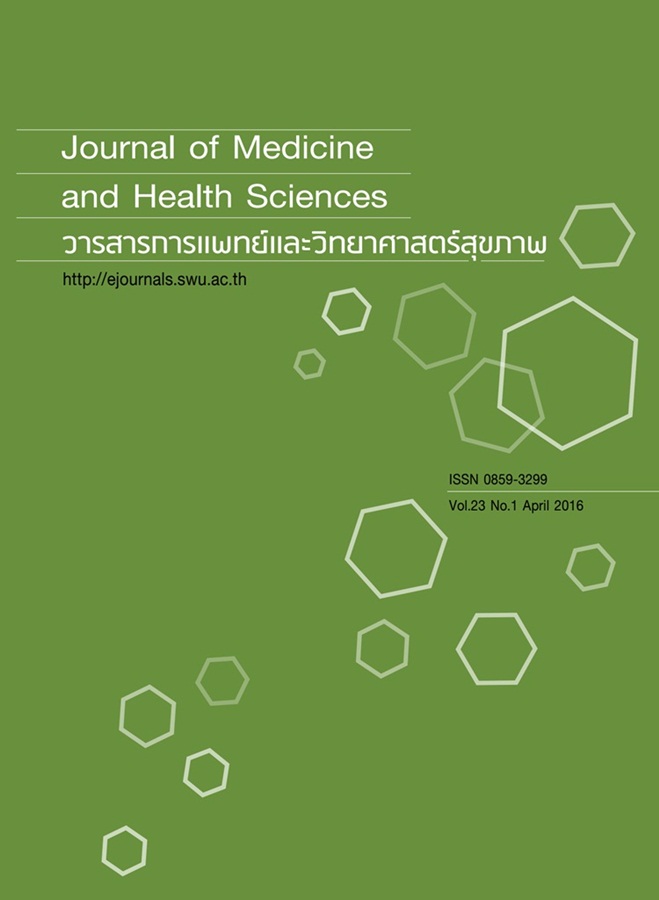Latch score and exclusive breastfeeding during the first six months postpartum
Keywords:
การเข้าเต้า, คะแนนการเข้าเต้า, การเลี้ยงลูกด้วยนมแม่อย่างเดียว, latch on, latch score, exclusive breastfeedingAbstract
The aim of this study was to effect of latch score on exclusive breastfeeding during first six months. The subjects were 3,065 uncomplicated postpartum women who delivered at HRH Princess Maha Chakri Sririndhorn medical center in Nakhon Nayok province since 2010 to 2012. At first day of postpartum, latch score was assessed by standardized trained nurses. Exclusive breastfeeding data was collected at the second day postpartum before maternal discharge. After maternal discharge, telephone follow-up on the postpartum day 7th, 14th, 45th and at the second, fourth and sixth month were used for exclusive breastfeeding data collection. It was found that on postpartum day 2nd, 7th, 14th, 45th and at the second, fourth and sixth month, the exclusive breastfeeding rates were 81.4, 79.8, 73.3, 56.8, 53.3, 36.7 and 31.3%, respectively. The latch score affected on exclusive breastfeeding at the second postpartum day. The latch score more than 8 was used to test exclusive breastfeeding at the second day postpartum. The positive predictive value was 98.5% (area under the curve = 0.72). The relative risk at this latch score was 22 (95% confidence interval between 10.9 and 44.4). The mean of latch score in exclusive breastfeeding group was significantly more than non-exclusive breastfeeding group at second and seventh postpartum day. So the latch score could be used to predict exclusive breastfeeding in early postpartum period.
คะแนนการเข้าเต้ากับการเลี้ยงลูกด้วยนมแม่อย่างเดียวในช่วงหกเดือนแรกหลังคลอด
การศึกษานี้ต้องการศึกษาผลของคะแนนการเข้าเต้าต่อการเลี้ยงลูกด้วยนมแม่อย่างเดียวในช่วงหกเดือนแรกหลังคลอด โดยเก็บข้อมูลจากมารดาหลังคลอดที่ไม่มีภาวะแทรกซ้อนที่ศูนย์การแพทย์สมเด็จพระเทพรัตนราชสุดาฯสยามบรมราชกุมารี ตั้งแต่ปี2553 ถึง 2555 จำนวนทั้งสิ้น 3,065 ราย โดยจะมีการประเมินคะแนนการเข้าเต้าในช่วงวันแรกหลังคลอดโดย พยาบาลผู้ผ่านการฝึกอบรม และมีการเก็บข้อมูลการเลี้ยงลูกอย่างเดียวในวันที่สองหลังคลอดก่อนมารดาได้รับการอนุญาต ให้กลับบ้าน หลังมารดากลับบ้าน มารดาจะได้รับการโทรศัพท์สอบถามข้อมูลการเลี้ยงลูกด้วยนมแม่อย่างเดียวในวันที่ 7, 14, 45 และในเดือนที่ 2, 4 และเดือนที่ 6 หลังคลอด จากการศึกษาพบว่ามีการเลี้ยงลูกด้วยนมแม่อย่างเดียวในวันที่ 2 วันที่ 7 วันที่14 วันที่45 เดือนที่2 เดือนที่4 และเดือนที่6 หลังคลอดร้อยละ 81.4, 79.8, 73.3, 56.8, 53.3, 36.7 และ 31.3 ตาม ลำดับ คะแนนการเข้าเต้ามีผลต่อการเลี้ยงลูกด้วยนมแม่อย่างเดียวในวันที่สองหลังคลอด คะแนนการเข้าเต้าที่มากกว่า 8 ใช้ ทำนายการเลี้ยงลูกด้วยนมแม่อย่างเดียวในวันที่ 2 หลังคลอดได้ร้อยละ 98.5 (พื้นที่ใต้กราฟเท่ากับ 0.72) และหากคะแนน การเข้าเต้ามากกว่า 8 จะมีโอกาสที่จะเลี้ยงลูกด้วยนมแม่อย่างเดียวในวันที่ 2 หลังคลอดสูงประมาณ 22 เท่าเมื่อเทียบกับ มารดาที่มีคะแนนการเข้าเต้าน้อยกว่าหรือเท่ากับ 8 (ช่วงค่าความเชื่อมั่นร้อยละ 95 เท่ากับ 10.9-44.4) สำหรับค่าเฉลี่ยของ คะแนนการเข้าเต้าในกลุ่มที่เลี้ยงลูกด้วยนมแม่อย่างเดียวสูงกว่ากลุ่มที่ไม่ได้เลี้ยงลูกด้วยนมแม่อย่างเดียวในการติดตามการ เลี้ยงลูกด้วยนมแม่ในวันที่ 2 และ 7 หลังคลอด ดังนั้น คะแนนการเข้าเต้าควรใช้ทำนายการเลี้ยงลูกด้วยนมแม่อย่างเดียวใน ช่วงแรกหลังคลอด






